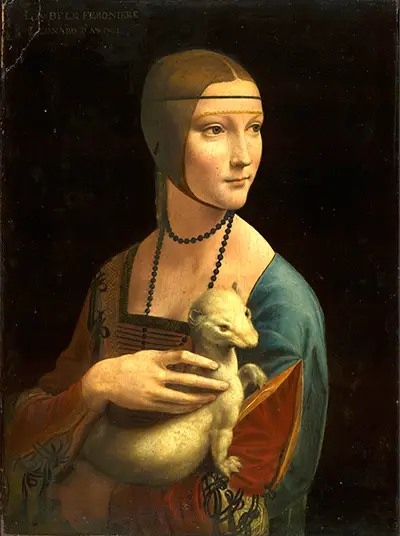Gallerani is widely recognised as the mistress of the Duke of Milan or Ludovico Sforza. Sforza was known to have had many mistresses despite being married to wife Beatrice d’Este.
Gallerani was his favourite mistress prompting the creation of the famous da Vinci portrait, the Lady with an Ermine.
The two supposedly met around 1489 when Gallerani left her home town of Siena, Italy. Sforza asked Gallerani to live in the Porta Giovia castle where he resided in Milan. Gallerani gave birth to their son Cesare in May of 1491.
Cesare was Gallerani’s first of five children. After the birth of Cesare, Sforza’s wife Beatrice soon found out about Gallerani’s relationship with her husband. Upon this discovery Beatrice demanded that Sforza must force Gallerani to leave the castle immediately.
Gallerani’s relationship with Sforza did not continue after this incident, however she later married Count Ludovico Carminati in 1492 who it is said she had her final four children with.
The impeccable portrait depicts Gallerani as a figure of purity and innocence. It is one of only four paintings of women that da Vinci created in his career. In addition it is one of the three oil paintings done by da Vinci in the World.
The white Ermine or Stoat which is found in Gallerani’s arms is a symbol of virginity. Because of the secrecy of Sforza and Gallerani’s relationship the two are not seen together in the painting.
Many professional critics infer that the Ermine is in place of Sforza if his relationship with Gallerani did not have to be kept private. The story of these two famous lovers is very intriguing and relevant to Italian history. Sforza and Gallerani are important historical Italian figures.
Being the Duke of Milan Sforza held the second highest hereditary title in all of Italy. Because of this his affair with Gallerani became a famous one after surfacing. The shock factor of his infidelity is higher than usual because of his position and power.
People in such a position are expected to have a higher degree of loyalty and trust. With his scandalous behaviour the citizens of Milan may have felt as though Sforza was dishonest and untrustworthy.
The Lady with an Ermine was kept in Italy to around 1800 when Prince Adam Czartoryski of Poland purchased it from an anonymous seller in Italy while travelling through the country.
The legality of this purchase is controversial because there is no known record of provenance from the painting. After obtaining the portrait Prince Adam took the painting back to his home in Krakow Poland, here the portrait would be displayed in the Czartoryski museum, a gallery established by his Mother Izabela Czartoryska.
The gallery was created as a way to preserve the national identity of the Polish people. After its arrival in Poland the painting underwent several restorations, one of these restorations included the addition of the inscription La Bele Feroniere Leonardo d’awinci in the top left corner of the portrait.
And the original dark blue background was painted black, this change is very disputable because it completely alters the appearance of the painting. Critics claim it almost makes Gallerani appear as a cut out rather than as an inclusion of her surroundings.
1830 marks a significant time of conflict in Poland, Russian forces have established control of certain portions of the Country after the Napoleonic wars. And tired of being controlled by Russia and seeking their independence, the Polish army fought back to control Russian occupied land.
The Czartoryski museum was overtaken during the rebellion. In fear of the portrait being destroyed or stolen, Izabela transported the portrait to family owned land in Sienna Poland.
There the Lady with an Ermine was kept safely for nine years until 1843. Thereafter it was relocated to be displayed at the Hotel Lambert in Paris which was owned by Prince Adam.
At the time of World War 1 the Lady with an Ermine was once again relocated to be safely kept. This time the portrait was sent to the Dresden gallery in Germany.
After the war it was once again sent back to the Czartoryski museum, there is was kept until 1939 the beginning of World War 2.
The portrait serves as an important piece to Poland’s heritage because of its incredible story of survival.
The Lady with an Ermine was able to survive through multiple vigorous wars, with a high risk of being damaged, lost or destroyed. But the persistence to keep this work safe was surprisingly successful as the portrait suffered no damage or destruction.


